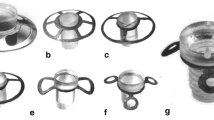Summary
Introduction: Areactive forms of keratitis in patients with seropositive rheumatoid arthritis are inflammations threatening the visual acuity and integrity of the eye. They commonly occur in a rheumatologically inactive interval and have a poor prognosis. A retrospective evaluation of medicamentous and surgical strategies for a curative therapy with optical rehabilitation is necessary to optimise the treatment of patients with necrotic sclerokeratitis.
Patients and methods: A total of 27 eyes of 22 patients (14 women and 8 men, ranging in age at the time of operation from 40 to 88 years; mean 68.7 years) with seropositive rheumatoid arthritis and secondary Sjögren's syndrome were reviewed retrospectively. There were 17 eyes with necrotic keratitis and 9 eyes with necrotic sclerokeratitis. In one eye, necrotic sclerokeratitis with bacterial transmigrating keratitis and hypopyon occurred. Operations: In 8 cases we performed a perforating mini-keratoplasty, in 16 cases a tectonic and optical perforating keratoplasty, in 3 cases a tectonic sclerokeratoplasty, in 9 patients a combined keratoplasty and cataract extraction with posterior chamber lens implantation and in 1 case a partial conjunctival plasty. Follow-up ranged from 7 months to 4 years (average 2.8 years).
Results: In all eyes, a sufficient tectonic and primary curative effect was achieved only under cyclophosphamide immunosuppression. In 3 cases, a rekeratoplasty had to be performed because of recurrent keratitis after changing the systemic cyclophosphamide therapy to methotrexate, glucocorticosteroids or non-steroid antiphlogistic agents. Visual acuity outcome was depending on the eccentricity of the keratoplasty and earlier affections of the eye. Postoperatively, the visual acuity improved in 23 eyes. In 3 cases, no change of visual acuity was achieved. Visual acuity deteriorated in one case from counting fingers to hand motions. Peri- and postoperative complications during the follow-up period were corneal infiltration around sutures in 4 eyes, graft rejecting reactions in 3 cases, and sicca syndrome in 6 cases.
Conclusions: The intensive cooperation of ophthalmologists and rheumatologists enables the successful treatment of apparently hopeless situations in necrotic sclerokeratitis in patients with seropositive rheumatoid arthritis. The rate of complications under an immunosuppressive therapy with cyclophosphamide was found at average 2.8 years follow-up to be low. The indication for the combined therapy depends on the ophthalmological findings; rheumatologists and ophthalmologists should decide on the appropriate dosage for the systemic cyclophosphamide therapy. Topical glucocorticosteroid therapy alone is contra-indicated.
Zusammenfassung
Hintergrund: Areaktive Keratitiden bei chronischer Polyarthritis (cP) sind den Visus und die Integrität des Auges bedrohende Entzündungen, die meist in einem rheumatologisch inaktiven Intervall auftreten und eine schlechte Prognose haben. Die retrospektive Auswertung medikamentöser und chirurgischer Strategien zur kurativen Therapie mit optischer Rehabilitation ist für die Optimierung der Behandlung dieser Patienten wichtig.
Patienten und Methoden: Untersucht wurden 22 Patienten mit 27 erkrankten Augen bei bekannter seropositiver chronischer Polyarthritis und sekundärem Sjögren-Syndrom. 14 Patienten waren weiblich, 8 männlich. Das Patientenalter betrug zum Zeitpunkt der Operation 40–88 Jahre (Mittelwert: 68,7 Jahre). 17 Augen hatten eine nekrotisierende Keratitis, 9 Augen eine nekrotisierende Sklerokeratitis und ein Auge eine Sklerokeratitis mit bakterieller Durchwanderungskeratitis und Hypopyon. Es wurden eine tektonische und optische perforierende Keratoplastik in 16 Fällen, eine tektonische Mini-Keratoplastik in 8 Fällen und eine tektonische Sklerokeratoplastik in 3 Fällen durchgeführt. Kombinierte Eingriffe mit simultaner Hinterkammerlinsenimplantation erfolgten davon 9 mal, mit partieller Bindehautdeckung einmal. Der Nachbeobachtungszeitraum lag zwischen 7 Monaten und 4 Jahren, im Durchschnitt bei 2,8 Jahren.
Ergebnisse: Ein tektonischer und primär kurativer Effekt wurde bei allen Augen nur unter Immunsuppression mit Cyclophosphamid erzielt, in 3 Fällen mußte nach Umstellung der systemischen Therapie von Cyclophosphamid auf Methotrexat, Glukokortikoide oder nichtsteroidale Antiphlogistika bei rezidivierender Keratitis eine Re-Keratoplastik durchgeführt werden. Der Visusverlauf war abhängig von der Exzentrizität der Keratoplastik und von Vorerkrankungen. In 23 Fällen stieg der Visus postoperativ an. In 3 Fällen blieb der Visus unverändert, in einem Fall fiel er postoperativ von Fingerzählen auf Handbewegungen ab. An peri- und postoperativen Komplikationen traten im Nachbeobachtungszeitraum 4× Fadeninfiltrate, 3× Transplantatreaktionen und 6× eine Sicca-Problematik auf.
Schlußfolgerungen: Durch eine intensive interdisziplinäre Kooperation von Ophthalmologen und Rheumatologen können aussichtslos erscheinende Situationen am Auge beherrschbar werden. Die Häufigkeit von Komplikationen unter Immunsuppression mit Cyclophosphamid ist zumindest mittelfristig im Nachbeobachtungszeitraum von durchschnittlich 2,8 Jahren als gering einzuschätzen. Die Indikation zur systemischen Therapie hängt vom augenärztlichen Befund ab, die Dosierung der systemischen Immunsuppression erfolgt durch Rheumatologen und Ophthalmologen. Eine alleinige topische Glukokortikoidtherapie ist kontraindiziert.
Similar content being viewed by others
Author information
Authors and Affiliations
Rights and permissions
About this article
Cite this article
Wiezorrek, R., Bialasiewicz, A., Engelmann, K. et al. Combined immunosuppressive and surgical therapy of necrotic keratitis in rheumatoid arthritis. Ophthalmologe 95, 619–624 (1998). https://doi.org/10.1007/s003470050324
Published:
Issue Date:
DOI: https://doi.org/10.1007/s003470050324




